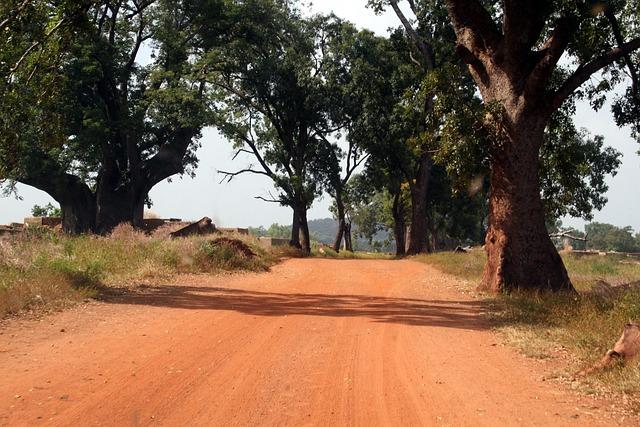In a world increasingly dominated by headlines of conflict and humanitarian crises, Burkina Faso has emerged as a stark reminder of the challenges facing marginalized populations.For the second consecutive year, the West African nation has been identified as the most neglected crisis, according to a recent report by CNN. This designation highlights not onyl the intensifying struggles of its citizens amid escalating violence and displacement but also underscores the alarming global indifference towards their plight. As Burkina Faso grapples with mounting insecurity, food shortages, and a deteriorating humanitarian situation, this article explores the underlying causes of its neglect, the implications for its population, and the urgent calls for international attention and intervention. With millions at risk of famine and basic human rights violations, the situation in Burkina Faso demands a renewed focus and a concerted effort to bring the crisis into the global spotlight.
Burkina Faso’s Escalating Humanitarian Crisis and Its Global Implications
The humanitarian crisis in Burkina faso continues to deepen, affecting millions and drawing minimal global attention. Over 3 million people are currently displaced within the country due to escalating violence and widespread poverty. The unprecedented levels of food insecurity compound the situation, with estimates suggesting that approximately 4.9 million individuals may face severe hunger by the end of the year. Despite these alarming figures, the international community’s response remains tepid, contributing to the perception of Burkina Faso as the most neglected crisis for two consecutive years. Humanitarian organizations are struggling to mobilize resources, leading to stark contrasts in living conditions and health outcomes among affected populations, particularly children and women who bear the brunt of the crisis.
The implications of this neglect are far-reaching, not just for Burkina Faso but possibly for regional stability and global security as well. The rise in extremist violence in the Sahel—largely fueled by a lack of basic services and governance—has led to increased recruitment into militant groups, making the region a significant concern for international peacekeeping efforts. Countries surrounding Burkina Faso, such as Mali and Niger, are also experiencing spillover effects, which could exacerbate existing tensions. Without urgent assistance and a coordinated international response, the cycle of poverty, violence, and displacement is likely to persist, creating a breeding ground for further crises that could affect global markets and security.
| Key Statistics | Current Figures |
|---|---|
| People Displaced | 3 million+ |
| Severely Food Insecure | 4.9 million |
| Child Malnutrition Rate | Over 10% |
| Humanitarian Appeal Funding | 51% |
The Causes of Neglect: Understanding the Overlooked Factors in Burkina Faso
The multifaceted causes of neglect in Burkina Faso are deeply intertwined with political, economic, and social factors. Ongoing conflict and instability have rendered large areas of the country inaccessible, leading to a substantial displacement of populations. Coupled with this unrest is the escalation of poverty, which has restricted the government’s ability to provide basic services such as healthcare and education. Many communities struggle to access essential resources and experience food insecurity due to the deteriorating agricultural conditions influenced by climate change and land degradation. The persistent presence of extremist groups compounds these issues, diverting attention and resources away from humanitarian needs and into counter-insurgency efforts.Moreover, the neglect of international attention further exacerbates the situation.Despite the evident humanitarian crisis,Burkina Faso has faced challenges in securing funding and support due to competing crises around the world. Lack of infrastructure plays a significant role as well; in many rural areas, roads are inadequate, hindering the delivery of aid and assistance to those in need. The interactions between these elements create a cycle of neglect that is arduous to break. In addition, the limited access to details means that the plight of Burkina Faso frequently enough goes unheard in global discussions, further entrenching the factors that lead to chronic neglect and inaction.
| Contributing Factors | Impact |
|---|---|
| Ongoing Conflict | Displacement and humanitarian access issues |
| Poverty Escalation | lack of basic services and essentials |
| Climate Change | Agricultural degradation and food insecurity |
| Lack of International Attention | Insufficient funding and support |
| Poor Infrastructure | Hindered aid delivery and response |
| Limited Access to Information | Global neglect of the crisis |
The Human Toll: Lives Affected by Malnutrition and Displacement in Burkina Faso
The ongoing crisis in Burkina Faso has left countless individuals grappling with the dual challenges of malnutrition and displacement. As political instability and violence plunge the region into chaos, humanitarian needs have surged. The impact on children is particularly alarming, with many facing severe malnutrition, which not only stunts their physical growth but also impairs their cognitive growth. Estimates suggest that over 2 million children require urgent nutritional support, while families are being forced to flee their homes, leading to chaotic and overcrowded living conditions in makeshift camps.
Displaced populations face a combination of health, safety, and educational challenges that exacerbate their plight. Many children are unable to attend school,distancing them from any semblance of normalcy in their lives. Additionally, access to basic healthcare services is severely limited, leaving families vulnerable to outbreaks of preventable diseases. Recent reports indicate that the following factors substantially contribute to the crisis:
- Increased violence: Armed conflicts disrupt daily life and place families at risk.
- Food insecurity: The rising cost of food and disruption of agricultural activities have led to widespread hunger.
- Lack of humanitarian aid: Limited access for relief organizations hampers response efforts.
International Response: Assessing Aid Efforts and Their Effectiveness
Despite the growing humanitarian crisis in Burkina Faso, the international community’s response has been alarmingly insufficient. Aid organizations report that funding for relief efforts remains far below the required levels to address the escalating needs of the population. This shortfall is exacerbated by competing global crises, straining resources that could otherwise be allocated to helping Burkinabe people. Consequently, essential services such as healthcare, education, and food security are severely undermined, forcing communities to rely on limited local support systems.
To better understand the effectiveness of international aid efforts, it is indeed crucial to evaluate the existing initiatives and their impact on the ground. Efforts can be categorized into several key areas:
- Emergency Relief: Short-term aid aimed at addressing immediate needs like food and shelter.
- Health Services: Initiatives focused on providing medical assistance and vaccinations.
- Education Programs: Efforts to establish learning environments for children displaced by conflict.
- Livelihood Support: Programs facilitating economic growth through skills training and job creation.
The effectiveness of these aid efforts can be quantified in terms of reach and impact. Below is a summary table highlighting ongoing initiatives and their assessed effectiveness:
| Initiative Type | reach (Individuals Served) | Impact Rating (1-5) |
|---|---|---|
| Emergency Relief | 500,000 | 4 |
| Health Services | 300,000 | 3 |
| Education Programs | 150,000 | 4 |
| Livelihood Support | 200,000 | 5 |
Analyzing these initiatives reveals mixed results, suggesting that while some programs have been triumphant, overall coordination and funding remain critical issues. The stark contrast between the high need and the inadequate response underscores the urgency of re-evaluating international priorities towards what is now deemed one of the world’s most neglected crises.
Path Forward: Recommendations for Addressing the Crisis in Burkina Faso
To effectively address the ongoing crisis in Burkina Faso, it is crucial for both national and international stakeholders to prioritize extensive and lasting strategies.Some key recommendations include:
- Strengthening Local Governance: Empower local authorities through decentralization to ensure they have the resources and autonomy necessary to respond to community needs effectively.
- Enhancing Security Measures: Increase support for local security forces, while ensuring that their operations are conducted with respect for human rights to regain public trust.
- humanitarian assistance: Boost funding for humanitarian aid to provide immediate relief to displaced populations and those affected by violence.
- Long-Term development Programs: Invest in education, health, and infrastructure to build resilience and address the root causes of conflict and instability.
Moreover, fostering regional cooperation can significantly enhance efforts to stabilize Burkina Faso. Initiatives should include:
| Initiative | Description |
|---|---|
| Joint Military Operations | Collaborate with neighboring countries to conduct joint operations against extremist groups. |
| Shared Intelligence | establish a regional intelligence-sharing network to track and respond to threats swiftly. |
| Cross-Border aid Programs | Develop programs to assist populations affected by conflicts in the region, fostering solidarity and support. |
Mobilizing Global Attention: Strategies to Raise Awareness and Action for Burkina Faso
In light of Burkina Faso being recognized as the most neglected crisis for a second consecutive year, it is imperative to adopt innovative strategies that can draw global attention to this urgent humanitarian situation. Effective mobilization relies on a multifaceted approach that engages various stakeholders across different platforms. Key strategies to consider include:
- Leveraging Social Media: Utilize platforms like Twitter,Instagram,and Facebook to share compelling visuals,survivor stories,and urgent calls to action.
- Collaboration with Influencers: Partner with global influencers and celebrities to amplify messages and reach wider audiences.
- Grassroots Campaigns: Foster community-led initiatives that encourage local voices to share their experiences and needs, providing authenticity and urgency.
- Creative Fundraising Events: Organize events that not only raise funds but also educate participants about the situation in Burkina Faso.
In addition to these strategies, forming partnerships with NGOs and international organizations can significantly enhance visibility and resource allocation. Building a coalition of voices from diverse backgrounds creates a more robust and credible narrative. A collaborative table might look as follows:
| Association | Role | Focus Area |
|---|---|---|
| UNICEF | Advocacy | Child Protection |
| World Food Program | Support | Food Security |
| Oxfam | Collaboration | Emergency Response |
These partnerships not only enhance resource sharing but also create a united front that can better advocate for the needs of those in Burkina Faso. By engaging a wide array of supporters and stakeholders, it is possible to cultivate a sustained dialog that calls for immediate action and sustained international focus on this critical issue.
In Summary
the designation of Burkina Faso as the most neglected crisis for the second consecutive year underscores a critical humanitarian situation that demands immediate global attention. The alarming increase in violence, displacement, and food insecurity illustrates the urgent need for international aid and policy intervention. As governments and organizations aim to prioritize resources and responses in conflict-ridden regions, it is vital that Burkina Faso does not fall further into the shadows of global neglect. Addressing the crisis requires a concerted effort not only to alleviate immediate suffering but also to forge a sustainable pathway toward stability and peace for the millions affected. By amplifying awareness and fostering collaboration among stakeholders, there remains a hope that Burkina Faso’s plight will gain the necessary visibility and support it urgently needs.

